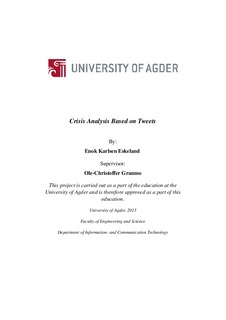Crisis analysis based on tweets
Master thesis
Permanent lenke
http://hdl.handle.net/11250/137594Utgivelsesdato
2013Metadata
Vis full innførselSamlinger
Sammendrag
Information from the public during a crisis is often limited to people calling emergency
services. Social media provides new opportunities to get input from the
public during times of crisis. To avoid reading through massive amounts of social
media data a system automatically detecting events is advantageous. Twitter’s
simple format makes it easy to create tweets, although analyzing them is more of
a challenge. The tweet stream’s high noise ratio combined with the shear amount
of tweets makes detecting events a formidable challenge. To be able to detect any
crisis events, the solution of this thesis is constructed as a general event detector,
but with emphasis on spatial detection. This makes it possible not only to detect
events, but in many cases also to estimate the location of these events. This approach
combines features from crisis centric event detectors with general event
detectors. The solution is constructed as a three part pipeline. The first part retrieves
tweets. The second part detects events and is called the detection pipeline.
The last part is a website called Grapher. It visualizes the detected events. The
detection pipeline is the core of the solution. It consists of a temporal, word density
and two spatial detection methods. In addition the detection pipeline clusters
the suggested words from the methods. The detection methods are based on comparing
two statistical models based on historic data and new data. The two spatial
methods and the temporal method detects words and locations by comparing kernel
density estimates with a state-of-the-art method. The solution pipeline has
been extensively tested on real data. It is able to detect both crisis events and
events of a more general character. For general events it has an event noise ratio
of 65%. For crisis events it has an event noise ratio of 94%. The results show
the proposed detection methods are viable and thus impacting the field of social
media event detection. The solution could be applied by crisis handling teams and
organizations monitoring social media in a specific area.
Beskrivelse
Masteroppgave i informasjons- og kommunikasjonsteknologi IKT590 2013 – Universitetet i Agder, Grimstad
